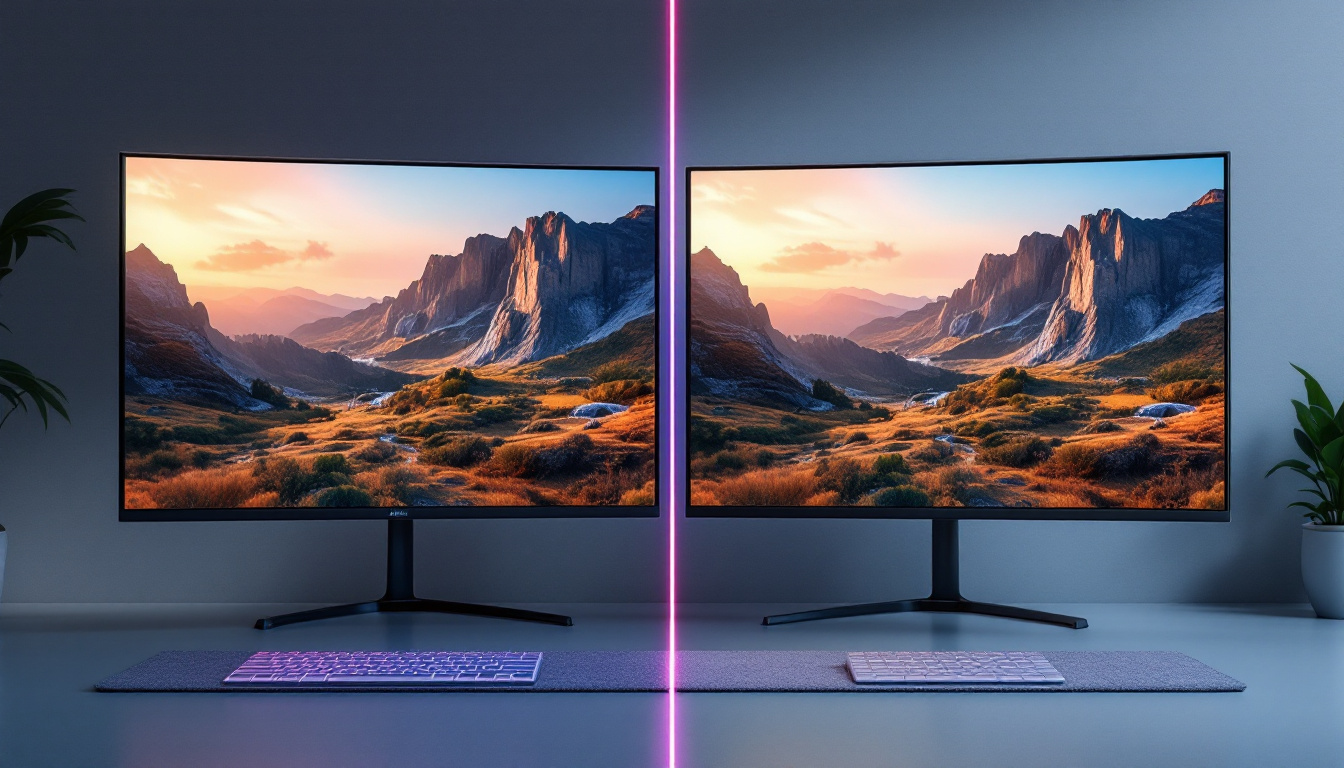Plasma Vs LCD: LED Display Explained
In the realm of television technology, the debate between plasma and LCD displays has been a topic of discussion for years. As technology has evolved, so too have the features and qualities of these two types of displays. This article aims to explore the differences, advantages, and disadvantages of plasma and LCD displays, providing readers with a comprehensive understanding of each technology.
Understanding the Basics
Before delving into the specifics of plasma and LCD displays, it is essential to grasp the fundamental principles behind each technology. Both types of displays utilize different methods to produce images, which ultimately affects their performance, color accuracy, and viewing experience. As technology continues to evolve, understanding these foundational concepts will help consumers make informed decisions when selecting a display that suits their needs.
What is Plasma Technology?
Plasma displays operate using small cells filled with gas that, when electrified, produce ultraviolet light. This light then excites phosphors coated on the inside of the cell, resulting in visible light that creates the images on the screen. Plasma screens are known for their ability to produce deep blacks and vibrant colors, making them a popular choice for movie enthusiasts and gamers. Additionally, plasma technology excels in displaying fast-moving images without blurring, which is particularly beneficial for sports viewing or action-packed video games. However, it’s worth noting that plasma displays can be heavier and consume more power compared to their LCD counterparts, which may be a consideration for some buyers.
What is LCD Technology?
Liquid Crystal Display (LCD) technology, on the other hand, relies on liquid crystals sandwiched between two layers of glass. When an electric current passes through the liquid crystals, they align to allow varying amounts of light to pass through. This light is typically provided by a backlight, often LED in modern displays. LCDs are known for their energy efficiency and slim profile, making them a popular choice for a wide range of applications. Moreover, advancements in LCD technology, such as the introduction of IPS (In-Plane Switching) panels, have significantly improved color accuracy and viewing angles, allowing for a more immersive experience whether you are watching a movie or working on graphic design. While LCDs may not achieve the same level of black depth as plasma displays, their versatility and affordability have made them a staple in both home and commercial environments.
Comparative Analysis of Plasma and LCD Displays
When comparing plasma and LCD displays, several factors come into play, including picture quality, energy consumption, lifespan, and price. Understanding these differences can help consumers make informed decisions based on their viewing preferences and needs.
Picture Quality
Picture quality is often the most significant factor in choosing between plasma and LCD displays. Plasma screens excel in producing deep blacks and excellent color accuracy, particularly in darker scenes. This is largely due to their ability to turn off individual pixels completely, resulting in true black levels.
On the other hand, LCD displays, especially those equipped with LED backlighting, have made significant strides in picture quality. While they may not achieve the same level of black depth as plasma, advancements in technology have improved their color reproduction and contrast ratios. Additionally, LCDs tend to maintain brightness levels better in well-lit environments, making them more versatile for various viewing conditions. Furthermore, many modern LCDs incorporate technologies such as quantum dots and local dimming, which enhance color vibrancy and contrast, further closing the gap with plasma displays.
Energy Consumption
Energy efficiency is another critical aspect to consider. Plasma displays generally consume more power than their LCD counterparts, especially when displaying bright images. This is due to the fact that plasma screens require more energy to illuminate the gas within the cells.
In contrast, LCD displays, particularly those using LED backlighting, are designed to be more energy-efficient. They consume less power, making them a more environmentally friendly option. This can lead to lower electricity bills over time, especially for users who watch television for extended periods. Moreover, as energy efficiency becomes a more pressing concern for consumers, many manufacturers are focusing on developing even more energy-efficient models, which can further enhance the appeal of LCD technology in a market that increasingly values sustainability.
Lifespan and Burn-In Issues
The lifespan of a display is an important consideration for consumers. Plasma screens typically have a lifespan of around 30,000 to 60,000 hours, depending on usage and settings. However, they are susceptible to burn-in, a phenomenon where static images can leave a permanent mark on the screen if displayed for too long.
LCD displays, on the other hand, do not suffer from burn-in issues, making them a safer option for users who frequently watch content with static logos or images. Their lifespan can extend beyond 60,000 hours, particularly with advancements in technology and manufacturing processes. Additionally, LCDs are generally more resilient to environmental factors such as humidity and temperature fluctuations, which can affect the performance of plasma screens. This durability makes LCDs a practical choice for diverse settings, from home theaters to commercial displays, where reliability and longevity are paramount.
Cost Considerations
When it comes to purchasing a television, cost is often a deciding factor. Plasma displays, while offering superior picture quality, have generally been more expensive due to their manufacturing processes. However, as technology has progressed, prices for plasma TVs have decreased, making them more accessible to consumers.
Price of Plasma Displays
Plasma TVs are often found at competitive prices, especially in larger screen sizes. This makes them an attractive option for those looking for an immersive viewing experience without breaking the bank. However, it’s important to note that the market for plasma displays has diminished in recent years, leading to fewer options and potentially higher prices for remaining models.
Price of LCD Displays
LCD displays are widely available and come in a range of prices, making them suitable for various budgets. The competition in the LCD market has driven prices down, allowing consumers to find models that fit their financial constraints without sacrificing quality. Whether seeking a budget-friendly option or a high-end model, there is likely an LCD display to meet those needs.
Viewing Angles and Motion Blur
Another crucial aspect to consider when comparing plasma and LCD displays is viewing angles and motion blur. These factors can significantly impact the overall viewing experience, particularly in group settings or during fast-paced action scenes.
Viewing Angles
Plasma displays generally offer superior viewing angles compared to LCDs. This means that viewers can enjoy consistent color and brightness levels even when sitting off to the side of the screen. This characteristic makes plasma displays ideal for larger rooms where multiple viewers may be seated at different angles.
Conversely, LCD displays can suffer from color distortion and reduced brightness when viewed from sharp angles. However, newer models with advanced technologies, such as IPS (In-Plane Switching), have improved viewing angles, making them more competitive with plasma displays.
Motion Blur
Motion blur is another consideration, particularly for sports enthusiasts and gamers. Plasma displays typically handle fast-moving images better than traditional LCDs, resulting in smoother motion and less blurring during action sequences. This is due to the faster response times of plasma technology.
While LCD displays have improved in this regard, some models still struggle with motion blur, especially in lower-end versions. High-refresh-rate LCDs and advanced motion interpolation technologies can help mitigate this issue, providing a smoother viewing experience.
The Future of Display Technology
As technology continues to evolve, the landscape of display technology is changing. While plasma and LCD displays have been the dominant players for years, new technologies such as OLED (Organic Light Emitting Diode) and MicroLED are gaining traction and may redefine the viewing experience.
The Rise of OLED Technology
OLED technology offers many advantages over both plasma and LCD displays. Each pixel in an OLED display emits its own light, allowing for perfect black levels and exceptional color accuracy. This technology also eliminates the risk of burn-in, making it a compelling option for consumers.
As OLED displays become more affordable and widely available, they may overshadow both plasma and LCD technologies. However, the current market still sees a healthy competition, with each technology offering unique benefits to cater to different consumer needs.
MicroLED: The Next Frontier
MicroLED is another emerging technology that promises to combine the best features of both OLED and LCD displays. MicroLED displays consist of tiny, self-emitting pixels, allowing for high brightness levels, excellent color accuracy, and no burn-in issues. As this technology matures, it could revolutionize the display market and provide consumers with even more options.
Conclusion
In the battle of plasma vs. LCD displays, each technology has its strengths and weaknesses. Plasma displays are renowned for their superior picture quality, deep blacks, and vibrant colors, making them a favorite among cinephiles and gamers. However, they consume more power, have a shorter lifespan, and are prone to burn-in issues.
On the other hand, LCD displays offer energy efficiency, a longer lifespan, and a wider range of price points. While they may not match the picture quality of plasma displays, advancements in technology have significantly improved their performance, making them a versatile choice for various viewing environments.
Ultimately, the decision between plasma and LCD displays will depend on individual preferences, viewing habits, and budget considerations. As new technologies emerge, consumers will have even more options to enhance their viewing experience, ensuring that the world of display technology continues to evolve.
Discover the Future of Display Technology with LumenMatrix
As you consider the advantages of plasma and LCD displays, we invite you to experience the next leap in visual technology with LumenMatrix. Our innovative LED display solutions, including Indoor and Outdoor LED Wall Displays, Vehicle LED Displays, and more, are designed to transform your viewing experience. Whether you’re looking to captivate an audience, enhance brand visibility, or create a dynamic environment, LumenMatrix is at the forefront of LED display innovation. Check out LumenMatrix LED Display Solutions today and see how we’re revolutionizing visual communication with displays that dazzle and deliver with unparalleled clarity and impact.































